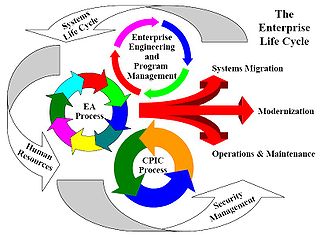Interoperability is a characteristic of a product or system to work with other products or systems. While the term was initially defined for information technology or systems engineering services to allow for information exchange, a broader definition takes into account social, political, and organizational factors that impact system-to-system performance.
Enterprise architecture (EA) is a business function concerned with the structures and behaviors of a business, especially business roles and processes that create and use business data. The international definition according to the Federation of Enterprise Architecture Professional Organizations is "a well-defined practice for conducting enterprise analysis, design, planning, and implementation, using a comprehensive approach at all times, for the successful development and execution of strategy. Enterprise architecture applies architecture principles and practices to guide organizations through the business, information, process, and technology changes necessary to execute their strategies. These practices utilize the various aspects of an enterprise to identify, motivate, and achieve these changes."

Enterprise integration is a technical field of enterprise architecture, which is focused on the study of topics such as system interconnection, electronic data interchange, product data exchange and distributed computing environments.

The Department of Defense Architecture Framework (DoDAF) is an architecture framework for the United States Department of Defense (DoD) that provides visualization infrastructure for specific stakeholders concerns through viewpoints organized by various views. These views are artifacts for visualizing, understanding, and assimilating the broad scope and complexities of an architecture description through tabular, structural, behavioral, ontological, pictorial, temporal, graphical, probabilistic, or alternative conceptual means. The current release is DoDAF 2.02.

NetOps is defined as the operational framework consisting of three essential tasks, Situational Awareness (SA), and Command & Control (C2) that the Commander (CDR) of US Strategic Command (USSTRATCOM), in coordination with DoD and Global NetOps Community, employs to operate, manage and defend the Global Information Grid (GIG) to ensure information superiority for the United States.
The British Ministry of Defence Architecture Framework (MODAF) was an architecture framework which defined a standardised way of conducting enterprise architecture, originally developed by the UK Ministry of Defence. It has since been replaced with the NATO Architecture Framework.
The Joint Capabilities Integration and Development System (JCIDS), is the formal United States Department of Defense (DoD) process which defines acquisition requirements and evaluation criteria for future defense programs. JCIDS was created to replace the previous service-specific requirements generation system that allowed redundancies in capabilities and failed to meet the combined needs of all US military services. In order to correct these problems, JCIDS is intended to guide the development of requirements for future acquisition systems to reflect the needs of all four services by focusing the requirements generation process on needed capabilities as requested or defined by one of the US combatant commanders. In an ideal implementation of the JCIDS process, regional and functional combatant commanders give early and continuous feedback into the acquisition and sustainment processes to ensure their current and evolving requirements are known and met.
Enterprise systems engineering (ESE) is the discipline that applies systems engineering to the design of an enterprise. As a discipline, it includes a body of knowledge, principles, and processes tailored to the design of enterprise systems.
LandWarNet (LWN) is the United States Army’s contribution to the Global Information Grid (GIG) that consists of all globally interconnected, end-to-end set of Army information capabilities, associated processes, and personnel for collecting, processing, storing, disseminating, and managing information on demand supporting warfighters, policy makers, and support personnel. It includes all Army and leveraged Department of Defense (DOD)/Joint communications and computing systems and services, software, data security services, and other associated services. LandWarNet exists to enable the warfighter through Mission Command, previously described as Battle Command. Other U.S. service equivalent efforts to LandWarNet include the Navy's "FORCEnet" and the Air Force's "C2 Constellation."
Human Factors Integration (HFI) is the process adopted by a number of key industries in Europe to integrate human factors and ergonomics into the systems engineering process. Although each industry has a slightly different domain, the underlying approach is the same.
DOTMLPF is an acronym for doctrine, organization, training, materiel, leadership and education, personnel, and facilities. It is used by the United States Department of Defense and was defined in the Joint Capabilities Integration Development System, or JCIDS Process as the framework to design what administrative changes and/or acquisition efforts would fill a capability need required to accomplish a mission. Because combatant commanders define requirements in consultation with the Office of the Secretary of Defense (OSD), they are able to consider gaps in the context of strategic direction for the total US military force and influence the direction of requirements earlier in the acquisition process, in particular, materiel.
Military capability is defined by the Australian Defence Force as "the ability to achieve a desired effect in a specific operating environment". It is defined by three interdependent factors: combat readiness, sustainable capability and force structure.

Enterprise life cycle (ELC) in enterprise architecture is the dynamic, iterative process of changing the enterprise over time by incorporating new business processes, new technology, and new capabilities, as well as maintenance, disposition and disposal of existing elements of the enterprise.

Generalised Enterprise Reference Architecture and Methodology (GERAM) is a generalised enterprise architecture framework for enterprise integration and business process engineering. It identifies the set of components recommended for use in enterprise engineering.
Live, Virtual, & Constructive (LVC) Simulation is a broadly used taxonomy for classifying Modeling and Simulation (M&S). However, categorizing a simulation as a live, virtual, or constructive environment is problematic since there is no clear division among these categories. The degree of human participation in a simulation is infinitely variable, as is the degree of equipment realism. The categorization of simulations also lacks a category for simulated people working real equipment.
Capability management is the approach to the management of an organization, typically a business organization or firm, based on the "theory of the firm" as a collection of capabilities that may be exercised to earn revenues in the marketplace and compete with other firms in the industry. Capability management seeks to manage the stock of capabilities within the firm to ensure its position in the industry and its ongoing profitability and survival.
Cyber Quest is an annual U.S. Army event held at Fort Gordon in which participants assess new technologies against documented Cyberspace, Electronic Warfare (EW), and Signal operational requirements. Cyber Quest is sponsored by the Cyber Battle Laboratory (CBL) of the Cyber Center of Excellence (CCOE)

Federated Mission Networking (FMN) is a significant initiative to help ensure interoperability and operational effectiveness of the North Atlantic Treaty Organization, it is a key contribution to the Connected Forces Initiative, helping Allied and Partner forces to better communicate, train and operate together. This includes the NATO Command Structure as well as the NATO Force Structure. The purpose of FMN is ultimately to support Command, Control, Communications, Computers, Intelligence, Surveillance and Reconnaissance (C4ISR) and decision-making in operations by enabling a rapid instantiation of mission networks. Including the NATO Command Structure, 37 nations have joined the FMN initiative as so called "FMN Affiliates" and work together under the FMN Framework Process to coordinate the design, development and delivery of operational and technical capabilities required to conduct net-centric operations. Each development increment is referred to as an "FMN Spiral". The respective requirements, architecture, standards, procedural and technical instructions are documented in so called "FMN Spiral Specifications". FMN Spiral Specifications are based on well known standards and best practices, hence supported by most off-the-shelf products and vendor neutral. TACOMS standards and profiles specify a common, technology and topology independent network interoperability layer for federated mission networks. There is also a rolling 10-year FMN Spiral Specification Roadmap of the envisioned future capabilities. At the same time, the Coalition Interoperability Assurance and Validation (CIAV) process ensures that current interoperability issues are being identified and fed back into FMN capability development.

This article outlines the present structure of the European Union's Common Security and Defence Policy (CSDP), a part of the Common Foreign and Security Policy (CFSP) based on articles 42–46 of the Treaty on European Union (TEU). Article 42.2 of TEU states that the CSDP includes the 'progressive framing' of a common Union defence policy, and will lead to a common defence, when the European Council of national heads of state or government, acting unanimously, so decides.

The NATO Science and Technology Organization (STO) is the primary NATO organization for Defence Science and Technology. Its intent is to maintain NATO's scientific and technological advantage by generating, sharing and utilizing advanced scientific knowledge, technological developments and innovation to support the Alliance's core tasks.








